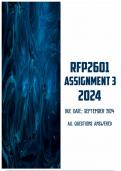, PLEASE USE THIS DOCUMENT AS A GUIDE TO ANSWER YOUR ASSIGNMENT
Please note that the author of this document will not responsibility for any plagiarizing you
commit.
Question 1
1. Fluency is one of the five essential components of reading.
1.1. Explain what is meant by reading fluency.
Reading fluency refers to the ability to read text not only accurately but also quickly and with proper
expression. It involves three main components: speed, accuracy, and prosody (the rhythmic and tonal
aspects of language). Fluent readers recognize words automatically, allowing them to focus on
comprehending the text rather than decoding individual words. This skill is critical as it bridges the
gap between word recognition and comprehension, enabling readers to understand and interpret texts
more effectively. A lack of fluency can lead to difficulties in understanding the material, as the
cognitive load of decoding words hinders comprehension. Therefore, developing fluency is essential
for overall reading proficiency and literacy development in the foundation phase.
1.2. Discuss why fluency in reading is important.
Fluency in reading is vital because it serves as the bridge between word recognition and
comprehension. Fluent readers can focus on understanding the text rather than decoding each word,
which enhances overall comprehension. This skill allows for smoother and more expressive reading,
making the reading experience more enjoyable and engaging. Additionally, fluency helps in building
confidence and motivation to read more, which further reinforces reading skills. In an educational
context, fluency is linked to academic success, as it enables students to handle more complex texts
and learn new information effectively. Without fluency, readers may struggle with comprehension,
leading to difficulties in all areas of learning.
1.3. What does fluency in reading involve?
Fluency in reading involves three key components: accuracy, speed, and prosody. Accuracy refers to
the correct recognition and pronunciation of words. Speed entails reading at an appropriate pace that
allows for comprehension without unnecessary pauses or hesitations. Prosody, the expressive aspect
of reading, includes proper intonation, stress, and rhythm, which contribute to the overall
understanding and enjoyment of the text. These components work together to enable readers to read
smoothly and efficiently, focusing on meaning rather than decoding. A fluent reader can thus
integrate these elements seamlessly, leading to better comprehension and a more engaging reading
experience.
, 1.4. Plan TWO (2) activities and explain how you will use each activity to improve the fluency
levels of reading of Grade 3 learners. Your activities must be an original effort.
Activity 1: Echo Reading Description:
In Echo Reading, the teacher reads a sentence
or a short passage aloud, and then the students
"echo" by repeating the same sentence or
passage. This method emphasizes proper
phrasing and expression, helping students to
develop a sense of rhythm and intonation in
their reading.
Implementation:
Choose a grade-appropriate text with clear,
expressive language.
Read the text aloud to the class, demonstrating
proper fluency.
Have the students repeat the text after you,
mimicking your pace, expression, and
intonation.
Gradually increase the length of the text
segments as students become more
comfortable with the activity.
Encourage students to practice echo reading in
pairs, where one student reads aloud and the
other echoes.
Benefits:
Improves students’ reading accuracy and
expression.
Reinforces the rhythm and flow of language.
Builds confidence in reading aloud.
Activity 2: Reader’s Theater Description:
Reader’s Theater involves students in reading
a script derived from literature. Students do
not memorize their parts; instead, they use
vocal expression to convey the story to the
audience.
Implementation:
Select a short play or script appropriate for
Grade 3 students.
Assign roles to students, ensuring that each
student has a part to read.
Allow students to practice their parts, focusing
on reading with expression and proper
phrasing.
Conduct a rehearsal where students read their
parts aloud in front of the class, encouraging
them to use gestures and facial expressions.




